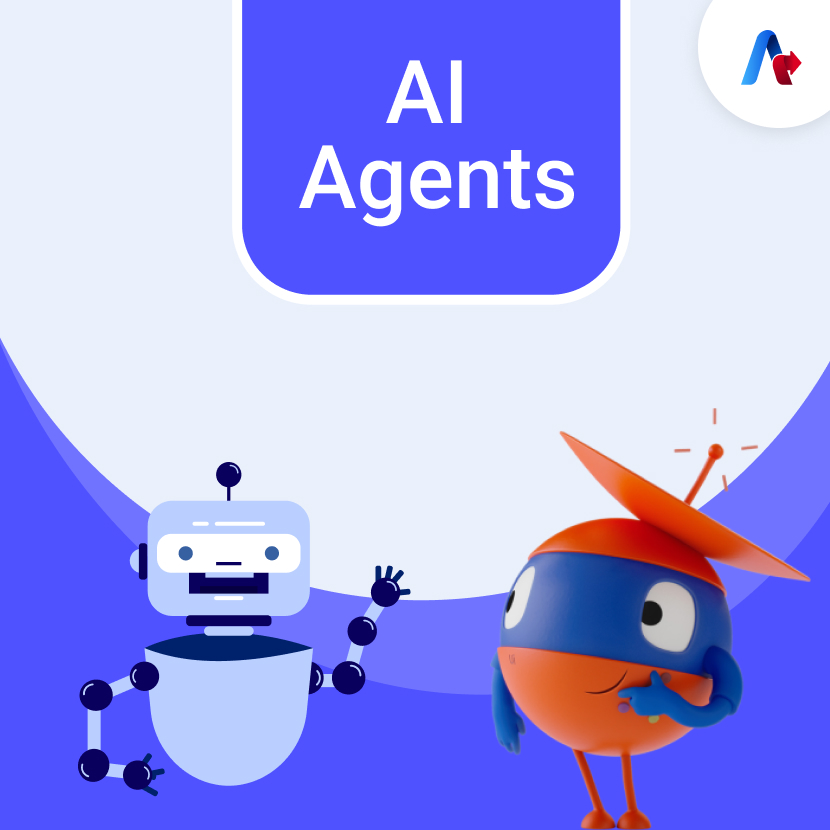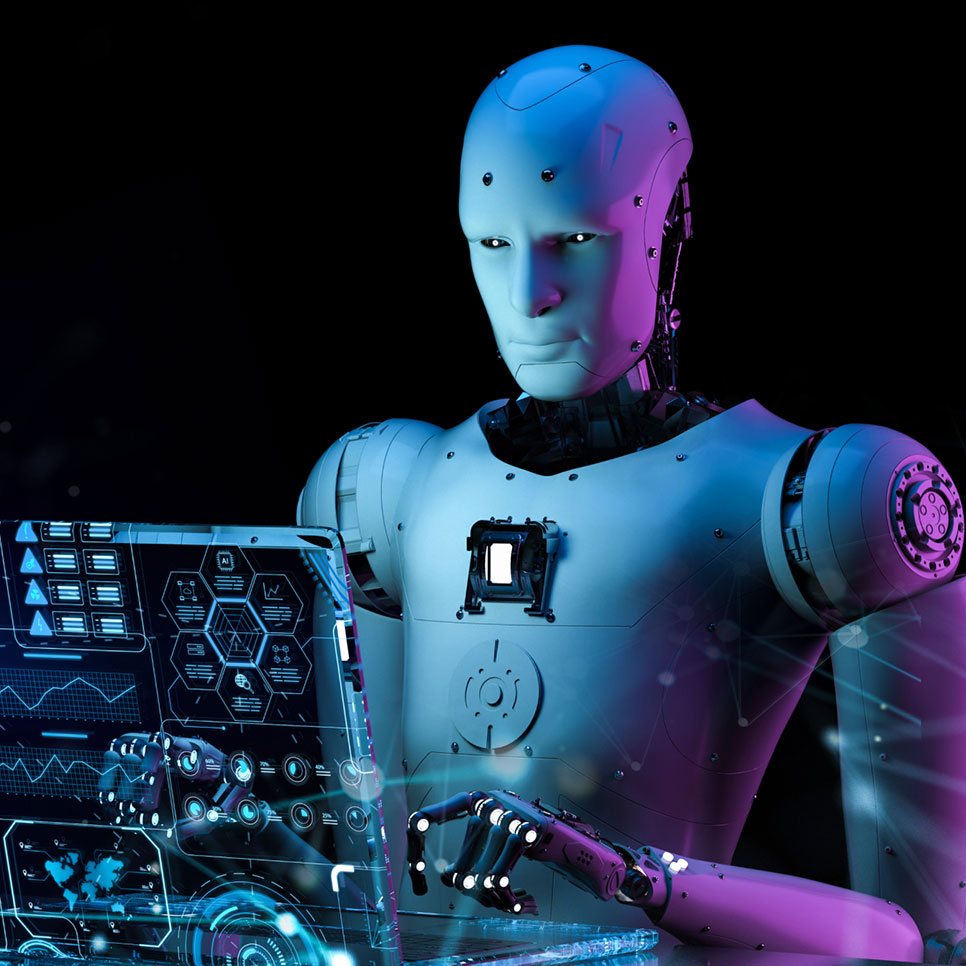Agentic AI
BLOG
15 min read
What is Agentic AI? The Next Generation of Intelligent Automation
A decade ago, nobody would have believed that machines could make decisions, set goals, and adapt on their own. But that is the world we are living in now-Agentic AI. These are no longer limited to predefined tasks and are designed to act with purpose, learn from their environment, and drive outcomes with minimal human input.
From manufacturing to retail, eCommerce, and more industries, Agentic AI services are redefining how businesses approach automation.
This blog will help you explore what Agentic AI is, how it differs from traditional AI, and its tremendous advantages.
What is Agentic AI?

The term "Agentic AI" describes AI systems that are capable of goal setting, decision-making, and autonomous action to accomplish desired results. Compared with traditional AI, it can adapt, learn, and take proactive action without continual human guidance.
As per a report by Gartner, by 2028, up to 33% of enterprise software apps will include Agentic AI. It will be up from less than 1% in 2024.
Agentic AI automation is expected to transform industries through its ability to automate tasks, improve decision-making, and offer personalized experiences. Hence, regardless of the company size or products and services it lends, everyone can leverage the power of automation for better results.
Now that you know what Agentic AI is, let’s move forward to how it works.
The Evolution of Agentic AI Systems
It's important to understand what Agentic means and how it has evolved with time. Agentic AI is not just another development in automation and artificial intelligence: It's a transformation. Historically, automation was mostly dependent on Rule-Based Systems, where a set of stated rules dictated the entire behavior of systems. The emergence of machine learning facilitated models' learning from data and ensured the creation of a supervised learning technique that involved labeled data sets to train.
After that, deep learning was introduced, which used neural networks to analyze vast amounts of unstructured data. The involvement of several architectures, including Convolutional Neural Networks and Recurrent Neural Networks, made machines more intelligent in analyzing and interpreting complex data like images and natural language.
Then, in 2020, large language models like GPT-3 were involved, marking the primary steps of Agentic AI in understanding human text and context. It tackled the problem of extensive coding for running an automated system. The use of Transformer architectures allowed the concept of self-attention to function.
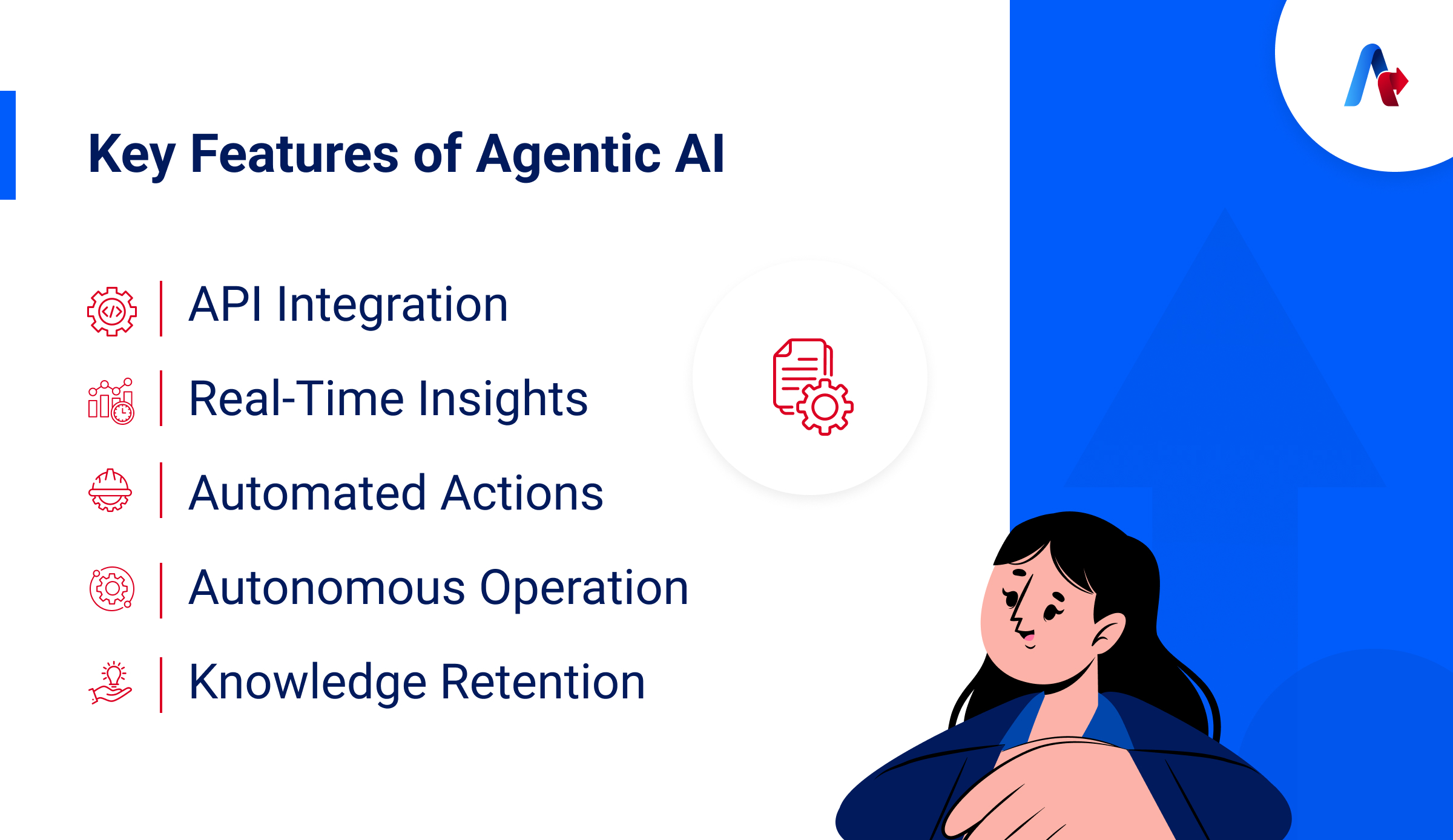
Agentic AI indicates Reinforcement Learning, which allows systems to optimize results based on feedback loops. AI agents create strategies depending on the outcomes, enhancing real-time decision-making attributes.
Gartner has highlighted in its reports that, by 2025, 75% of organizations will be using some type of Agentic AI, which specifies its future significance in business operations. Studies have further indicated that companies adopting this system can generate a 30% deduction from their operational expenses by automating routine tasks and enhancing their decision-making capabilities.
The key features include:
- Tool Calling: Agentic AI can access external API and information to make proper decisions.
- Discovery: It can gather real-time data from different sources, creating a place for optimized analysis.
- Execution: It can perform actions like sending emails and processing transactions without the requirement of human oversight.
- Autonomy: These systems can operate effectively due to self-prompting functions, making it easier to accomplish the goals.
- Memory: It can retain knowledge from past actions, highlighting better decision-making in the future.
What is Agentic Process Automation?
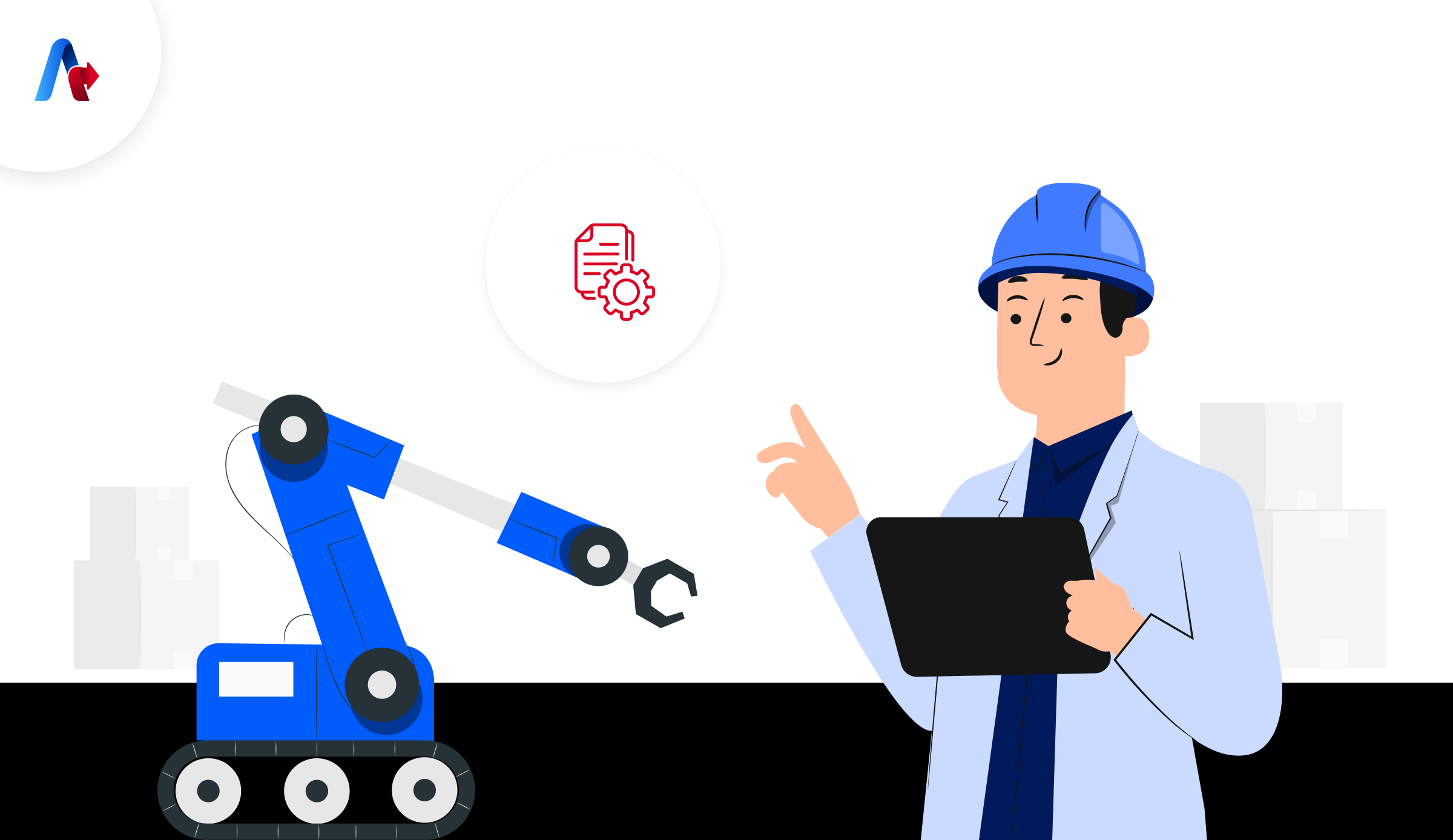
Agentic Process Automation (APA) has transformed conventional automation by incorporating advanced AI features that allow systems to work autonomously. Conventional automation relies on predefined scripts, while APA can use machine learning and natural language processing to solve problems and make real-time decisions.
APA's use of LLMs enhances responsiveness to interpret complex queries and take effective actions. This allows non-technical users to interact with systems and get their work done. They employ reinforcement learning techniques, which help them learn from historical data and adapt processes according to feedback loops, creating an effective chain of optimization.
APA can access and utilize APIs autonomously and execute transactions without human intervention. For example, an Agentic system can predict demand fluctuations and communicate with suppliers in supply chain management. Its design facilitates self-prompting while continuously checking the environment to act at the right moment. Agentic process automation is another step towards fully autonomous systems that optimize complex organization mechanisms with minimum human intervention.
Explore how Agentic AI can transform your business
Reach Out for a ConsultationHow Does Agentic AI Work?
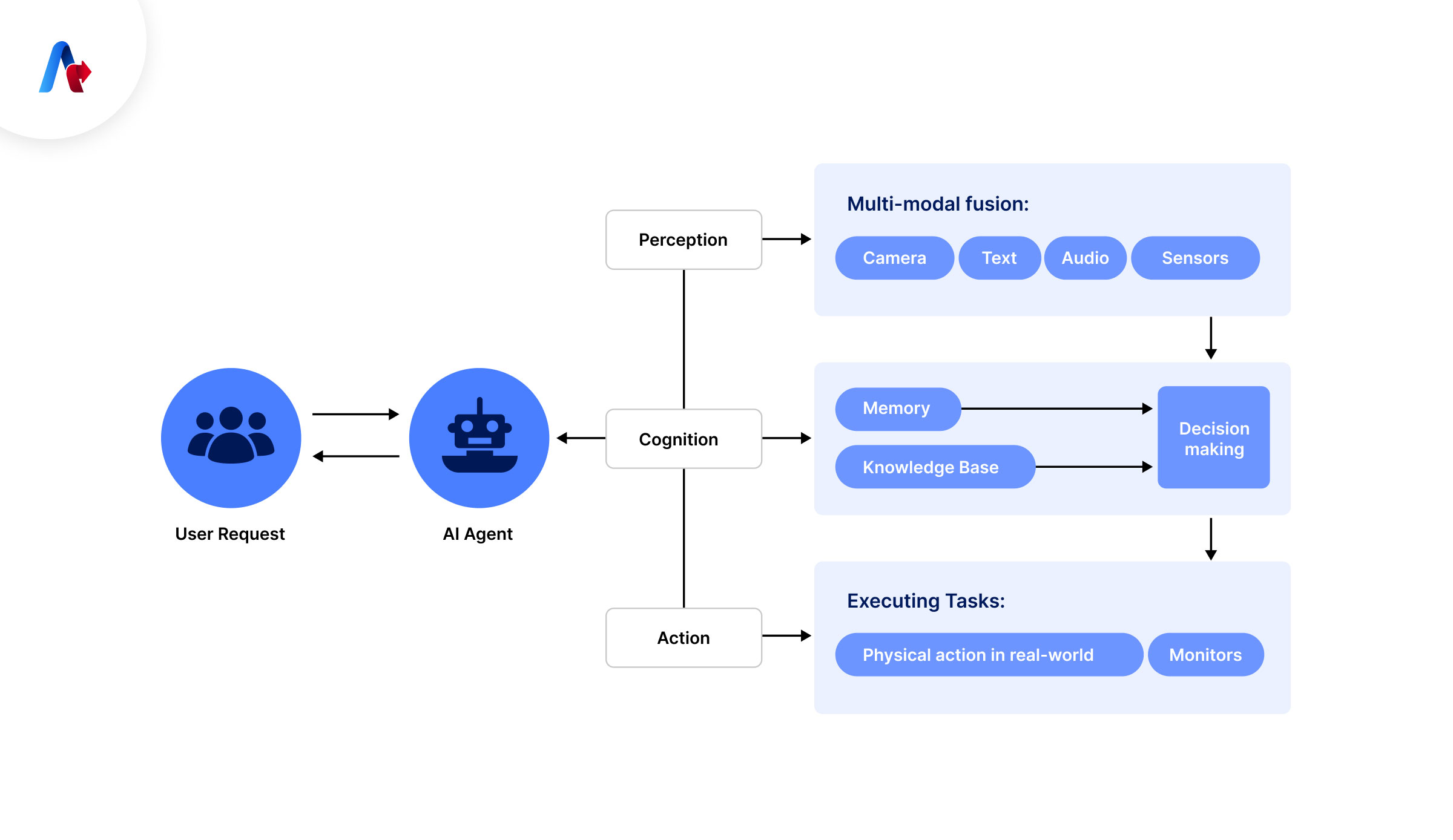
Agentic AI uses a network of intelligent, goal-driven agents that work both independently and cooperatively to complete complicated tasks. As each agent is built with distinct goals and abilities, it can collect data, make judgments, and act without continual human oversight. These agents can comprehend context, adjust to new inputs, and produce more individualized results over time with cutting-edge technology like machine learning, natural language processing, and real-time data analytics.
A report by Salesforce reports that 90% of global respondents prefer using an AI Agent to interact with the public sector.
Perception: Agents constantly take in data from a variety of digital sources, including sensors, user interfaces, and APIs, and transform it into organized insights.
Reasoning: To comprehend tasks and organize suitable actions, agents use language models and domain-specific logic to analyze data after it has been gathered.
Execution: Agents communicate with external platforms or systems to carry out tasks like scheduling, data entry, and content production. Their actions are in accordance with organizational policies and limitations, according to built-in restrictions.
Learning: Over time, agents improve their performance through feedback loops and interaction data. To make better decisions, they gain knowledge from user behavior, mistakes, and accomplishments.
Collaboration: Agents can divide tasks, exchange knowledge, and help one another accomplish more general goals, providing a more cohesive and intelligent system response.
The ability of agentic AI to autonomously manage workflows and adapt over time is what makes it unique. Using open-source or low-code frameworks, developers and companies can quickly experiment and customize agents. Agentic AI is turning into a useful tool in a variety of fields, including marketing optimization, sales automation, and customer experience.
Difference Between Agentic AI and AI Agents
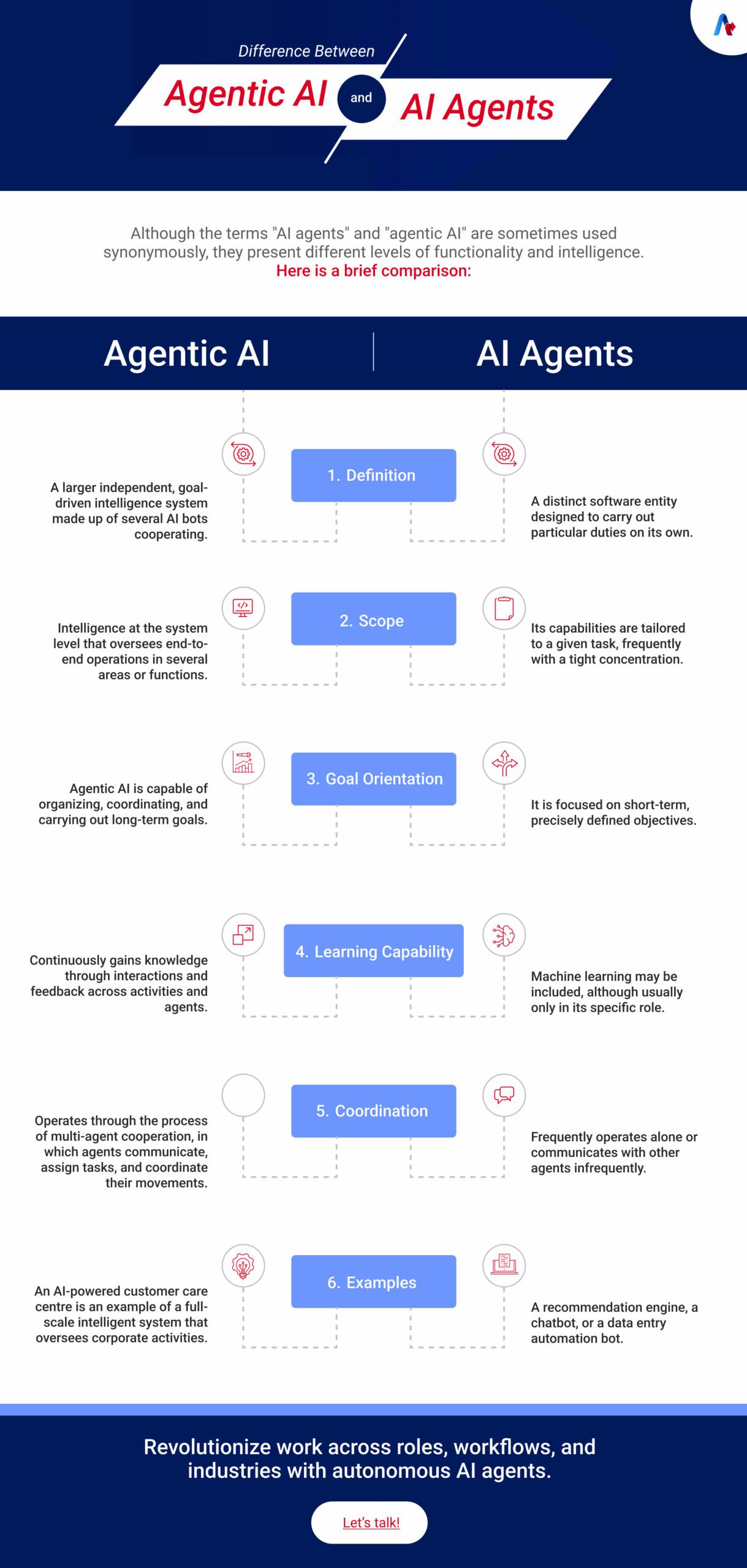
Although the terms "AI agents" and "agentic AI" are sometimes used synonymously, they present different levels of functionality and intelligence. Here is a brief comparison:
| Aspect | Agentic AI | AI Agents |
|---|---|---|
| Definition | A larger independent, goal-driven intelligence system made up of several AI bots cooperating. | A distinct software entity designed to carry out particular duties on its own. |
| Scope | Intelligence at the system level that oversees end-to-end operations in several areas or functions. | Its capabilities are tailored to a given task, frequently with a tight concentration. |
| Goal Orientation | Agentic AI is capable of organizing, coordinating, and carrying out long-term goals. | It is focused on short-term, precisely defined objectives. |
| Learning Capability | Continuously gains knowledge through interactions and feedback across activities and agents. | Machine learning may be included, although usually only in its specific role. |
| Coordination | Operates through the process of multi-agent cooperation, in which agents communicate, assign tasks, and coordinate their movements. | Frequently operates alone or communicates with other agents infrequently. |
| Examples | An AI-powered customer care centre is an example of a full-scale intelligent system that oversees corporate activities. | A recommendation engine, a chatbot, or a data entry automation bot. |
Revolutionize work across roles, workflows, and industries with autonomous AI agents.
Contact us todayHow Agentic AI Differs from Traditional AI and RPA?
| Feature | Agentic AI | Traditional AI | RPA |
|---|---|---|---|
| Operational Efficiency | Reduction of 50% in bottlenecks. | It varies, mostly less than 30%. | Reduces expenses by 30%. |
| Cost Reduction | The ability to adjust increases financial performance. | Static cost savings. | Cost savings as per fixed methods. |
| Scalability | Provides an increase of 60% in scalability. | Limited scalable options. | According to predefined workflows. |
Read More: Agentic AI vs Traditional RPA
Agentic AI gives automation an upper hand by emphasizing a level of autonomy that is missing from Conventional AI and Robotic Process Automation, Conventional AI is dependent on structured information and predefined algorithms, while Agentic AI uses LLMs that can easily analyze and structure data and respond in natural language.
RPA mainly automates tasks within defined workflows that demand structured scripting and human intervention. There is always a debate to choose between the two, Agentic AI and Generative AI, due to their functions. With Agentic AI having the potential to be capable of making choices, Generative AI can manage content creation, based on human input.
According to Gartner, RPA can minimize operational expenses by 30%; however, it still functions within the challenges of pre-configured scripts. On the other hand, Agentic AI can generate responses according to changing conditions in real-time, emphasizing efficiency and decision-making capabilities more.
RPA needs human oversight and extensive coding to set up and manage. Agentic AI has a self-prompting mechanism that allows systems to access, plan, and execute activities autonomously. The incorporation of real-time data and external APIs allows Agentic AI to optimize processes, making it easier for businesses to compete and sustain in this fast-paced environment.
Key Benefits of Agentic AI: Transforming Automation with Intelligence
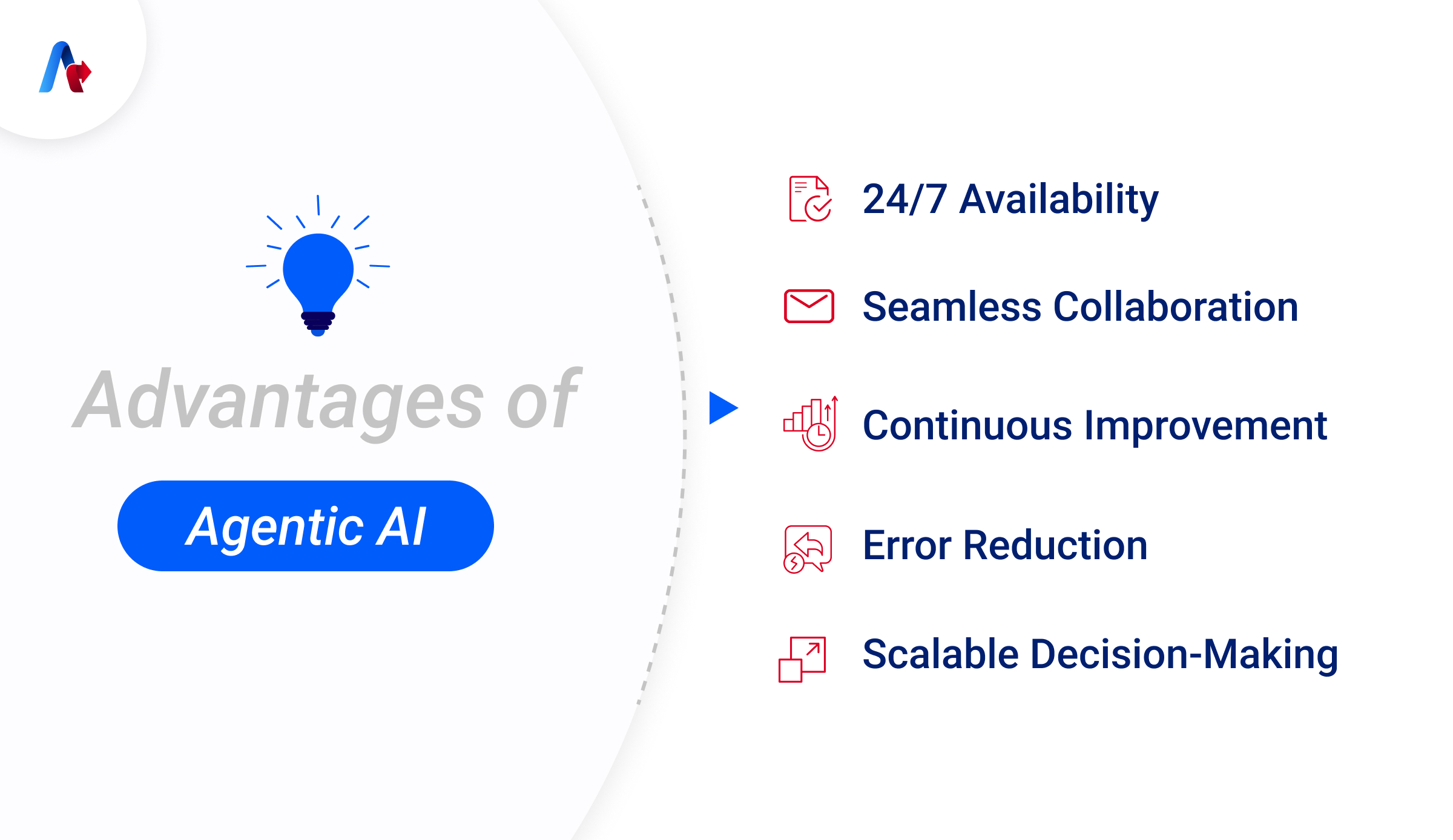
Agentic AI is changing the way we think about and use automation. It is taking automation a notch higher by allowing systems to operate independently and make decisions on their own. This technology can make work more efficient, reduce delays, and offer valuable insights based on data.
However, adopting Agentic AI also comes with some challenges, like setup complexity, security concerns, and the need for accurate data. That’s where an industry expert like Accelirate can help you create a clear roadmap.
Some of the major advantages of Agentic Automation includes:
1. Continuous Improvement
The purpose of Agentic AI systems is to learn from their results and experiences. Agentic AI agents continuously improve their actions, decision-making processes, and task performance through feedback loops and reinforcement learning. Because of their adaptability, they can gradually improve in accuracy, efficiency, and alignment with corporate objectives without requiring frequent reprogramming.
2. Seamless Collaboration
The ability of Agentic AI to collaborate with human users, other AI systems, and software platforms to coordinate workflows, exchange information, and resolve tasks makes it a proactive team member rather than merely a background tool. This collaboration between human and machine intelligence increases productivity, guarantees clarity in multi-agent tasks, and facilitates hybrid work environments.
3. 24/7 Availability
Agentic AI doesn't need downtime or rest like human teams do. It can operate consistently throughout shifts and time zones, delivering reliable results. Customer service, monitoring systems, and time-sensitive operations—where continuous interaction is crucial—benefit greatly from this.
4. Error Reduction
By adhering to preset guidelines, optimizing algorithms, and continuously validating data, Agentic AI helps minimize human errors that usually arise from inconsistencies, weariness, or oversight. This dependability lowers risks, increases compliance in regulated contexts, and improves total output quality.
5. Scalable Decision-Making
Agentic AI can quickly and accurately handle complicated circumstances by making decisions on its own across large systems and databases. It is perfect for companies that require constant decision-making in areas like supply chain management, financial operations, and fraud detection since it expands easily as workloads increase without sacrificing performance.
Want to dive deeper into AI Agents? Read our latest blog: What Are AI Agents and their Real-World Applications
Understanding the Implications of Agentic AI for Organizations
We will explore three sectors where Agentic AI is making strides, emphasizing dynamic automation and intelligent decision-making in real-time. Particularly, the Agentic AI use cases will be studied, to understand how it is being used in several industries.
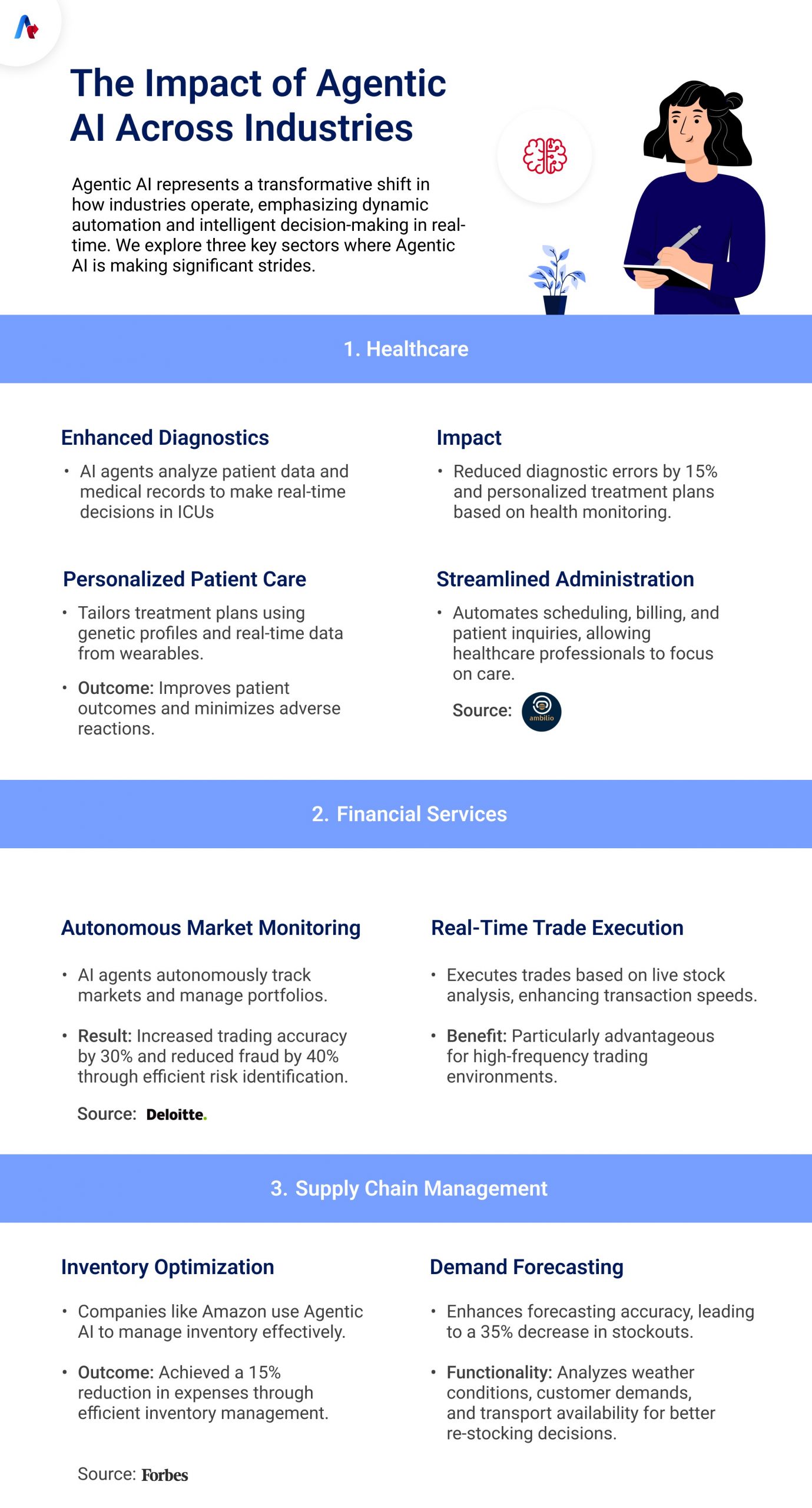
Healthcare
Agentic AI is becoming a domestic name within the healthcare sector, specifically in diagnostic and patient care. For example, AI agents are utilized to analyze and process patient data and medical records and make real-time decisions in ICUs. This approach has minimized diagnostic errors by 15% in specific systems and allows for a more customized patient treatment plan based on health monitoring (Source: McKinsey).
8 mins read
How AI Agents-Powered RPA Is Optimizing Revenue Cycle Management in Healthcare
Read MoreFinancial Services
Within finance, AI agents are helping to track and monitor markets and manage portfolios autonomously. The systems can execute trades based on real-time stock analysis. The use of these systems has shown an increase of 30% in trading accuracy by limiting human mistakes and maximizing the speeds of transactions. It has been highly beneficial for high-frequency trading. Certain banks have reported A reduction of 40% in frauds due to the use of agentic AI systems that identify risks efficiently (Source: Deloitte).
Supply Chain Management
The manufacturing and logistics sectors continually use AI agents to enhance operations and manage inventory. Amazon has initiated the use of Agentic AI systems to manage its inventory, leading to a 15% decrease in expenses. Other companies are implementing the systems in demand forecasting, resulting in a 35% decrease in stock-outs. Their autonomous capabilities are a great help in re-stocking and re-routing as they can analyze weather conditions, customer demands, and the availability of transport (Source: Forbes).
These Agentic AI examples create a clearer picture regarding its use, applications and real-life impact over several processes, Mostly, the caliber of generative AI has been exceeded with the introduction of Agentic AI enhancing the digital transformation at a rapid pace.
What's Your Use Case?
We have a solution
for you
Get Expert Consultation
What Risks and Challenges Come with Agentic AI Implementation?
Though Agentic automation provides various benefits to businesses, it also comes with several drawbacks. These include:
1. Lack of Human Oversight
Autonomy may be a risk as well as a strength. Unexpected outcomes could result from agentic AI making decisions without sufficient human oversight, particularly in delicate or high-stakes situations.
2. Data Privacy and Security Concerns
Large datasets are essential to Agentic AI systems. Data breaches, the misuse of private data, or non-compliance with privacy laws such as GDPR or HIPAA may result from improper governance.
3. Complex Debugging and Interpretability
The lack of transparency in agentic AI models, particularly those that use deep learning or reinforcement learning, can make it difficult to debug problems, comprehend decision routes, or assure responsibility.
4. Ethical and Bias Risks
Agentic AI agents can generate discriminatory or unethical results if they are trained on biased or unrepresentative data. These biases can grow rapidly and affect decisions made in the actual world if they are not properly restrained.
What’s Next for Agentic AI, Agentic Automation, and AI Agents?
As Agentic AI develops, it will move beyond task-specific automation to intelligent, end-to-end systems that require little supervision. It is anticipated that AI agents will become more contextually aware, personalized, and able to handle complete workflows on their own, whether in marketing, customer service, finance, or human resources.
In addition to learning user behavior, these agents will work with human teams and other agents to address challenging issues. Automating repetitive and data-intensive processes produces a dynamic, hybrid ecosystem that frees up human resources for innovation, creativity, and strategic thinking.
Self-improving agents that can modify their logic and architecture on the fly and even create new agents to meet new needs will also develop as adoption increases. Domain-specific agentic applications will be developed for industries such as healthcare, finance, logistics, and law to meet their needs.
At the same time, cross-platform presence will allow always-on agents to help consumers in a variety of settings and devices, including AR/VR and mobile. Stronger ethical and governance frameworks that put an emphasis on openness, security, and responsible AI use are required by organizations to facilitate this transition. These frameworks should also make sure that, as agents gain greater autonomy, they continue to be in line with human objectives and values.
Ready to take the next step with Agentic AI?
Get expert supportFinal Take: Why Agentic AI Deserves Your Attention
Businesses' ability to automate, adapt, and make decisions at scale has advanced significantly with the advent of Agentic AI. In contrast to conventional automation and Artificial Intelligence tools, it combines autonomy, contextual awareness, and ongoing learning to produce goal-oriented, real-time outcomes with little assistance from humans. The future of work is already being shaped by Agentic AI, from intelligent supply chain management to personalized customer experiences.
Agentic AI integration will become more of a need than a choice as businesses continue to look for faster, smarter, and more affordable solutions. Now is the perfect time to investigate how this next-generation AI method can boost productivity and creativity throughout your operations, regardless of how big or small your company is.

